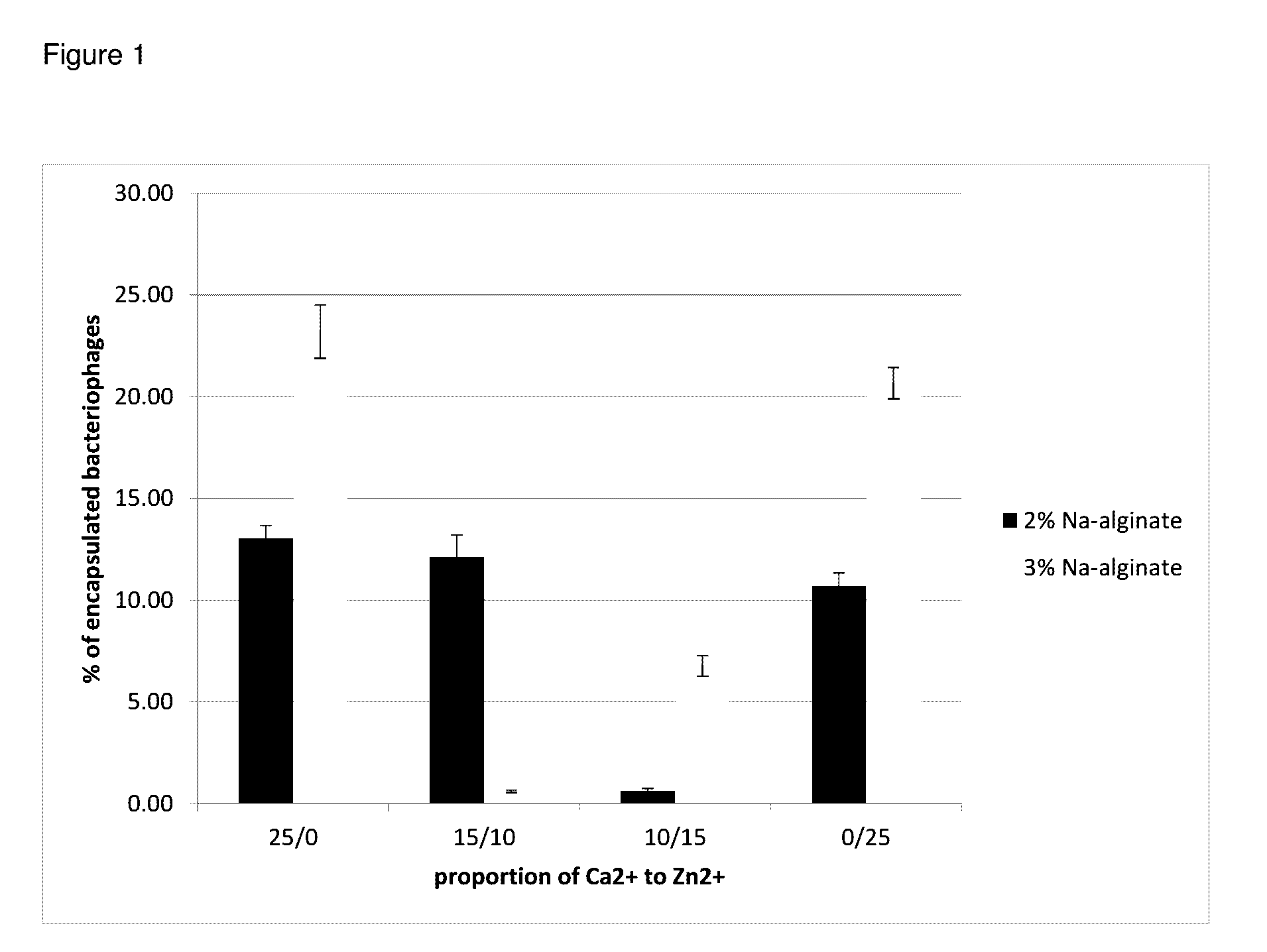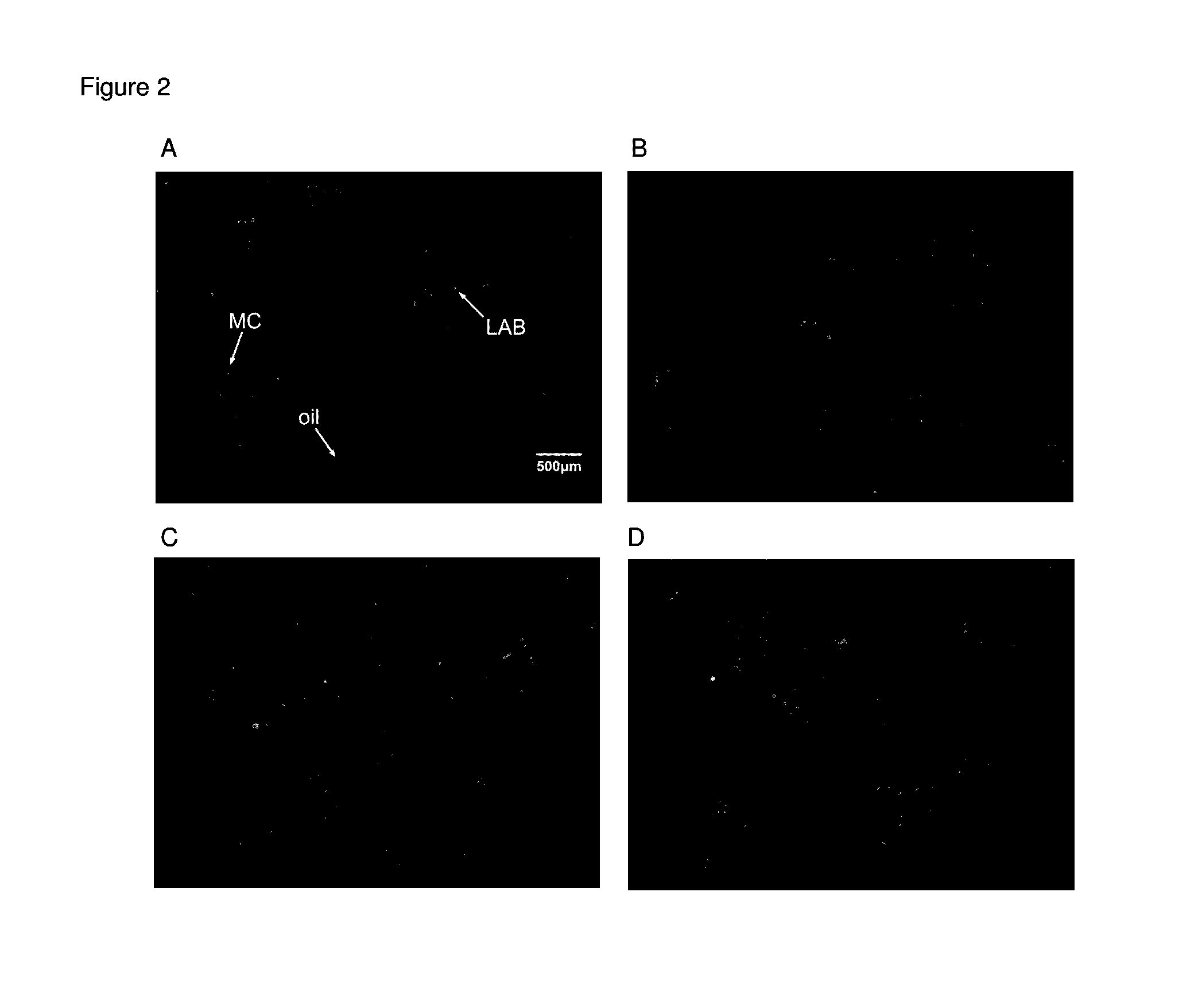Methods for encapsulation and microcapsules produced thereby
a technology of microcapsules and encapsulated materials, which is applied in the field of encapsulation, can solve the problems of no particular advantages of using zinc ions instead of calcium ions, barium and strontium are not approved for food and feed applications, etc., and achieve the effects of reducing pore size, ensuring integrity and viability of encapsulated materials, and being easy to apply
- Summary
- Abstract
- Description
- Claims
- Application Information
AI Technical Summary
Benefits of technology
Problems solved by technology
Method used
Image
Examples
example 1
Preparation of Material for Encapsulation Preparation of Bacteriophage Suspension Using Bacterial Culture
1.1: Preparation of Liquid LB Medium for Recovery of Host Bacterial Strain
[0076]A 2.5 g amount LB broth (Bio-Shop) was dissolved in about 90 ml of tap water. An aliquot of 20 μl of 5M NaOH solution (prepared in deionized water) was added and the solution obtained was made up to 100 ml using tap water, then stirred to ensure dissolution of the LB medium. The liquid LB medium obtained was divided to provide a volume of 20 ml in each of 5 Erlenmeyer flasks of 100 ml capacity. The 5 Erlenmeyer flasks containing 20 ml of liquid LB medium were autoclaved (15 min, 126° C., 1.4 bar) and then stored at room temperature.
1.2: Recovery of Host Bacterial Strain
[0077]An aliquot of 10 μl of bacterial glycerin stock (25% glycerin stock) was transferred into 20 ml of the liquid LB medium in Erlenmeyer flask of 100 ml capacity prepared as described in 1.1. The inoculated liquid LB medium was cultu...
example 2
Initial Experimental Preparation of Microcapsules Containing Bacteriophage and / or Bacteria
[0084]In early experiments, the influence of two variables on encapsulation efficiency was investigated.
2.1 Concentration of Sodium Alginate
[0085]The first variable investigated was the concentration of sodium alginate. To achieve the densest possible degree of cross-linking, increasing the concentration alginate biopolymer was considered. However, above 3% (w / v), alginate solutions reached a viscosity that was sufficiently high to prevent emulsification in subsequent process steps. Higher concentrations were also rejected because of the potential difficulties associated with scale-up of the production of capsules to a semi-industrial and then industrial scale. Preparation of a highly viscous polymer solution would require the use of strong mechanical stirrers and a large amount of energy. As a result, only 2% and 3% alginate solutions were analyzed when optimizing the process.
2.2 Addition of H...
example 3
Preparation of Microcapsules Containing Bacteriophage and / or Bacteria
[0096]To prepare material for encapsulation, 30 ml of phage / bacterial suspension (LAB in MRS medium (BTL), phages in M9 or LB broth (LabEmpire)) obtained according to the method described in Example 1 was warmed and maintained at 40° C. for 25 minutes in a 50 ml conical tube (Immuniq) in a water bath. 0.9 g of alginic acid sodium salt from brown algae (Sigma) was dissolved in the phage / bacterial suspension in a conical tube, on a vortex for 2 minutes. The Na-alginate solution obtained in the conical tube was de-aerated by allowing the solution to stand for 30 minutes at room temperature.
[0097]The solution was then dispersed in oil by pouring the Na-alginate solution from the conical tube into 50 ml of vegetable oil (Kujawski) containing 12 ml of Tween®80 (POCH or Sigma) in a 250 ml Erlenmeyer flask. The residual Na-alginate solution stuck to the walls of the conical tube eluted with 10 ml of oil on a vortex for 2 m...
PUM
| Property | Measurement | Unit |
|---|---|---|
| temperature | aaaaa | aaaaa |
| temperature | aaaaa | aaaaa |
| diameter | aaaaa | aaaaa |
Abstract
Description
Claims
Application Information
 Login to View More
Login to View More - R&D
- Intellectual Property
- Life Sciences
- Materials
- Tech Scout
- Unparalleled Data Quality
- Higher Quality Content
- 60% Fewer Hallucinations
Browse by: Latest US Patents, China's latest patents, Technical Efficacy Thesaurus, Application Domain, Technology Topic, Popular Technical Reports.
© 2025 PatSnap. All rights reserved.Legal|Privacy policy|Modern Slavery Act Transparency Statement|Sitemap|About US| Contact US: help@patsnap.com



